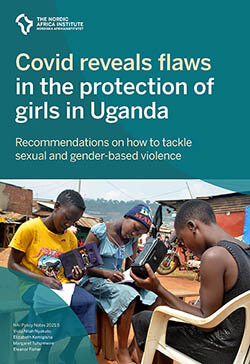
This op-ed was first published in STAT, a journal specializing in health, medicine, and the life sciences. Find out more.
The emergence of the Omicron variant of SARS-CoV-2 with its many mutations has rightly sparked global concern. Another COVID-related issue that should also spark concern, but continues to fly under the radar, is the endemic violence directed toward women and girls around the world that has been heightened by responses to the pandemic.
On a recent visit to a tribal village in South India, I met with children, elders, and teachers, who told me how their lives have been affected by COVID-19. The implementation of crucial, but often blunt, public health measures such as stay-at-home policies and the disruption of key services like schools and health facilities have significantly eroded social well-being, isolation, income, and educational attainment. They have also increased violence against many women and girls.
The stories I heard are echoed in towns and villages across the world, and the repercussions will be felt for years to come.
Even before the pandemic, almost 1 in 3 women experienced physical or sexual violence in their lifetimes, mostly by an intimate partner. Exposure to this violence has increased with the spread of COVID-19.Related: Rising to the challenge of screening for intimate partner violence during Covid-19
Throughout the pandemic, reduced social interaction and the removal of support mechanisms have taken a toll on mental health and escalated economic insecurity and social isolation for men and women, boys and girls. These are all risk factors for intimate partner/domestic violence. In addition, many children have dropped out of school which, for young girls, can result in early marriage and childbearing, or even sexual exploitation.
Some industry forecasts suggest that the supply of vaccines may outstrip demand by mid-2022. Even if this comes to pass, it does not mean the end of the pandemic is in sight.
Since COVID-19 emerged in December 2019, most governments have operated in crisis mode, with a narrow and short-term focus on trying to minimize the transmission of SARS-CoV-2; tracking the virus and the people it sickens; and, more recently, vaccinating their populations against it. Multisectoral approaches that, for example, consider the unique impact of emergency responses on vulnerable groups, such as women and girls, or the potential that these measures have to worsen in-country and global inequalities, is often simply not considered. The stark reality is that the impact of violence against women and girls and growing inequalities could be far greater and long lasting compared to the immediate toll of Covid-19 infections alone.
According to data from the United Nations, only 52 countries have integrated measures to prevent violence against women in their COVID-19 response plans. In some countries, however, resources focused on dealing with violence against women was diverted to manage COVID-19.
The International Science Council, along with the World Health Organization and the United Nations Office for Disaster Risk Reduction, have for the past year been engaging in an exercise to understand future scenarios that may unfurl from the pandemic. In my work for the WHO, I am part of a global panel supporting this effort to look at the impact of COVID-19 on the global community five years from now, with a focus on these critical areas: health, social, national governance, economics, global governance, the environment, and science and technology.
Our scenario planning finds that too many adverse social outcomes of the pandemic, such as the state of mental health, increasing violence or discrimination, and policies targeting inequalities, are not currently being addressed by the global community. Governments and multilateral actors have failed to consider longer-term outcomes and broader consequences of the pandemic on individual and social well-being.
The most likely scenario predicts that, five years hence, many societies will see heightened poverty and spikes in mental health conditions. Higher levels of anxiety, stress, and depression will lead to knock-on effects on physical health. And vulnerable family conditions combined with employment insecurity, social isolation, and reduced access to support services will likely exacerbate violence that disproportionately affects women and girls.
More must be done to prevent a generation of girls and women from being subject to harm today and to improve their health, well-being, and socioeconomic outcomes in the future.
An optimistic scenario presents a plausible picture in which the shock of the pandemic forces the global community to consider a systemic approach to pandemic planning and response. This necessitates a greater focus on gender equality. Governments must prioritize essential services — as well as quality data and research — to deal with violence against women and girls in response plans, backed by specific investment targeting women and girls living in the most vulnerable situations. Investing in women-led and women’s rights organizations is a must.
The full Covid-19 Scenarios Report will be published in January 2022.
Addressing inequalities today will not only improve lives as the world emerges from the COVID-19 crisis but will also provide vital lessons for future emergencies. No one has a crystal ball to predict what will come, but the message from this pandemic is clear: More girls and women will be harmed if the long-term harms of violence are not factored into pandemic responses and their welfare is not prioritized today.
Soumya Swaminathan is the chief scientist for the World Health Organization and is an observer for the ISC’s COVID-19 Outcome Scenarios Project.
This article supports the dialogue around the 16 days of action for the United Nations International Day for the Elimination of Violence Against Women.

Covid reveals flaws in the protection of girls in Uganda
This policy note was co-authored by researchers working on the Gold Matters: Sustainability Transformations in Artisanal and Small-scale Gold Mining project, which is part of the Transformations to Sustainability programme.
Image by Elliot Margolies on Flickr.